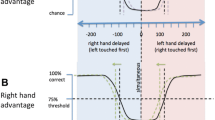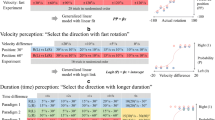Abstract.
Vestibular functions are known to show some deterioration with age. Vestibular deterioration is often thought to be compensated for by an increase in neck proprioceptive gain. We studied this presumed compensatory mechanism by measuring psychophysical responses to vestibular (horizontal canal), neck and combined stimuli in 50 healthy human subjects as a function of age (range 15–76 years). After passive horizontal rotations of head and/or trunk (torso) in complete darkness (dominant frequencies 0.05, 0.1, and 0.4 Hz), subjects readjusted a visual target to its remembered prerotational location in space. (1) Vestibular-only stimulus (whole-body rotation); subjects' responses were shifted towards postrotatory body position, this only slightly at 0.4 Hz and pronounced at 0.1 and 0.05 Hz. These errors reflect the known physiological drop of vestibular gain at low rotational frequency. They exhibited a slight but significant increase with age. (2) Neck-only stimulus (trunk rotated, head stationary); the responses showed errors similar to those upon vestibular stimulation (with offset towards postrotatory trunk position) and this again slightly more with increasing age. (3) Vestibular-neck stimulus combination during head rotation on stationary trunk; the errors were close to zero, independent of stimulus frequency and the subjects' age. (4) Opposite stimulus combination (trunk rotated in the same direction as the head, but with double amplitude); the errors were clearly enhanced, essentially reflecting the sum of those with vestibular-only and neck-only stimulation. Taken together, we find a parallel increase in neck- and vestibular-related errors with age, in seeming contrast to previous studies. We explain our and the previous findings by a vestibular-neck interaction model in which two different neck signals are involved. One neck signal is used, in combination with the vestibular signal, for estimating trunk-in-space rotation. It is internally shaped to always match the vestibular signal, so that these two signals cancel each other out when summed during head rotation on stationary trunk. Because of this matching, perceived trunk stationariness during head rotation on the stationary trunk is independent of vestibular deterioration (related to stimulus frequency, age, ototoxic medication, etc.). The other neck proprioceptive signal, coding head-on-trunk rotation, is superimposed on the estimate of trunk-in-space rotation, thereby yielding a notion of head-in-space. This neck signal remains essentially unchanged with vestibular deterioration. Generally, we hold that the transformation of the vestibular signal from the head down to the trunk proceeds further to include the hip and the legs as well as the haptically perceived body support surface; by this, subjects yield a notion of support kinematics in space. As a consequence, spatial orientation is impaired by chronic vestibular deterioration only to the extent that the body support is moving in space, while it is unimpaired (determined by proprioception alone) during body motion with respect to a stationary support.
Similar content being viewed by others
Author information
Authors and Affiliations
Additional information
Electronic Publication
Rights and permissions
About this article
Cite this article
Schweigart, G., Chien, RD. & Mergner, T. Neck proprioception compensates for age-related deterioration of vestibular self-motion perception. Exp Brain Res 147, 89–97 (2002). https://doi.org/10.1007/s00221-002-1218-2
Received:
Accepted:
Issue Date:
DOI: https://doi.org/10.1007/s00221-002-1218-2




